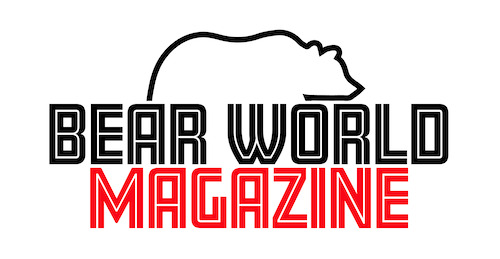Bear Tracks: Bears Down Under
If you were to ask an Ozzie or a Kiwi about bears (the animal) in Australia or New Zealand, they will tell you there are no bears Down Under. The closest thig to a native bear you will find is the Australian koala, misleadingly called a bear. They are, in fact, arboreal marsupials. Bears live throughout the northern hemisphere and all cultures north of the equator have created legends and assigned totemic meanings to their indigenous bears. Self-identifying gay bears Down Under embrace the American toy teddy bear for their totemic inspiration because, as Bob Hay put it, “the teddy in our view is an estimable animal which stands for the cuddly lovability we claim for ourselves.”
In 1990 David Hill brought the idea of organizing gay bears in Australia after a vacation in San Francisco. Described as a “charismatic, big and bearded man,” David Hill founded the Ozbears Australia in Sydney. The, Sydney, the largest city in Australia (Canberra is the capital), is also an international gay crossroads and as of 2000 had the second largest gay population after San Francisco. Here is where gay movements, fads, and fashions from abroad take root. In the early 1990s several bear clubs formed in quick succession across the nation continent. They began, generally, as small, informal groups, sometimes meeting in private homes for dinner, having picnics at the beach, as well as having bar nights.
The Sydney Ozbears organized a variety of activities for its members. It was noted for its weekly get together in an old factory building, where guys gathered to socialize, shared a light dinner, cuddled on old sofas, and “took the heritage walk” to the backroom, where free condoms and lube were provided. Foreign visitors, mostly Americans and Germans, frequently remarked on the immensely caring attitude among the Ozbears. This was due, in part, to Australian “mateship.” “Mateship” has been described as an Australian code of conduct that emphasizes egalitarianism and fellowship, and is a “stronger and tougher relationship” than friendship. It is a relationship that sprung up in the nineteenth century among penal colonists exiled from Britain and forced to endure great hardship.

(Mateship is something I valued in Derek Noakes, “my Aussie,” the first man I ever fell in love with. And in an odd way, mateship reminds me of the warmly welcoming attitude many immigrants to California were traditionally greeted with, a place that in the 1970s still had a frontier mentality of welcoming the steady stream of new arrivals to the Golden State. Chinese immigrants were the notable exception.)
New Zealanders identify themselves as kiwi bears, opting for the flightless bird native to their country and which appears as ubiquitously there as the bald eagle in the US or, until her recent demise, the bust of Queen Elizabeth II in Great Britain. Auckland, the largest city in New Zealand, is the first place many gay men move to. (Wellington is the capital.) They often move on to Sydney, some eventually landing in the US.
The idea of gay bears arrived in New Zealand inn 1985 thanks to the efforts of a man who John Webster identifies only as Peter. Peter, who had also lived in Canada and visited the United States, felt there must be other gay men in New Zealand who shared his passion for hirsute men. He advertised in a gay magazine his desire to form a correspondence network for like-minded men. He named the group Des Hirsutes: The Hairies and published a newsletter for two years.
Another man, whom John Webster identifies only as “Mel,” formed K.U.B.S. Kiwi Bears in 1992. He also circulated a newsletter and local bears in Auckland met in private homes and made various outings as a group to local restaurants and visits to other cities. Before the legalization of homosexuality in New Zealand in 1993, New Zealand bears were notably reserved or inhibited in expressing affection toward each other, an attitude rooted in conservative sexual values in New Zealand, according to John Webster.
The demise of Ozbears in Sydney in 1995 generated a lot of powerful emotions among gay bears in Sydney. The other clubs that existed at the time, however, were not affected. In that same year Harbor City Bears formed in Sydney. This new group worked hard to maintain an open club, accepting of bears from all walks of life. They fostered a close relationship with the leather community there. Early on there had been tensions between some bears and leathermen in Sydney. The early bear movement Down Under was focused on hairiness and affectionate behavior, and leather-related masculinity. As in the US, the early bears were no longer young gay men. For some, bears were an alternative to leather. For others there was a marked affinity between the two in their embrace of gay masculinity.

In quick succession other bear clubs formed. Every city—Sydney, Melbourne, Brisbane, Canberra, Perth, and Adelaide—all had a club. Some clubs remained informal groups, others incorporated. Bears Down Under was the first “virtual club” in Australia, formed in the earliest days of the internet, and was an email list.
The first bear competitions were held, and Bear Essentials ’97 (modeled on the large bear gatherings in the US) was a huge success. In May 1997 the Melbourne Bear and Cub Competition became the biggest thing to happen to gay bears in Australia up to that point. It made the local VicBears the largest gay social club in Melbourne, it became a national event, and established the VIcbears as one of the “big three” bear clubs in Australia, the other two being the Harbor City Bears and the Brisbears.
How has the bear community Down Under fared in recent years? I encourage residents and visitors to Australia and New Zealand to email me (leskwright53@gmail.com). I look forward to sharing with my readers what I learn.
Help Les K Wright in his quest to document bear history by joining the Bear History Project International where you and a group of like-minded individuals can exchange ideas and help to preserve bear history and culture.





















